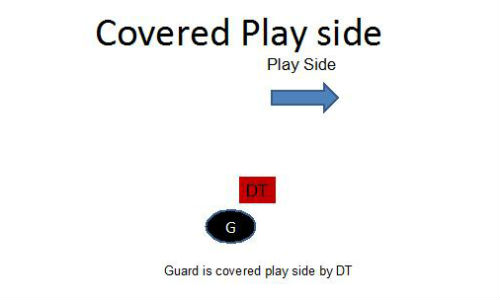Strategies for blocking covered vs. uncovered in inside zone runs

The inside zone run continues to be the most popular and probably most productive run concepts used by offensive coordinators at all levels of football.
What used to be more of an exclusive concept used at higher levels, the IZ is now common the youth level. But while many coaches utilize the inside zone scheme, many have different ways of blocking it.
And while there are volumes of literature written about this topic – including a 30,000-word study we conducted at XandO Labs – I want to recap our research by providing a background in the covered vs. uncovered methodology, which we found to be the most effective way of teaching the scheme.
In fact, 64.9 percent of coaches believe that the uncovered vs. covered methodology is the most productive way of blocking the inside zone scheme. Below, I explain how that method translate into one-on-one blocks in the inside zone.
What’s most effective about teaching this methodology is that the front that the defense presents is irrelevant. Whether it’s an over front, under front, odd front or bear front doesn’t matter. The only thing that matters is each player must know if they are the following:
- Covered playside
- Covered backside
- Uncovered open gap
- Uncovered closed gap
For clarification, “covered” is when a first level defender – walk-up linebacker or defensive lineman – is aligned over any part of the offensive lineman. Playside and backside in individual zone principals do not refer to the playside or backside of the line of scrimmage but to the playside or backside of the individual offensive lineman.
There is no “backside” of an inside zone scheme because of various entry points of the ball-carrier. The play can hit anywhere.

Definition: Covered playside indicates that the offensive lineman has a defensive lineman aligned on his playside shoulder.
Examples: Right guard on zone right against a 3-tech. The 3-technique is covering the guard and on the shoulder of the guard that the play is going to. On zone right, his right side is his playside and his left side is his backside.
Footwork and blocking technique: We’ve found two different one-on-one block techniques for this scenario: double-under and single-under. By definition, the double-under technique is a tight elbows, double-under lifting motion with a palms up, not thumbs out strike. A single-under is a “fingers first” technique whereas the flipper is the lead with the shoulder and elbow. Single under means that the blocker is making contact with the defender over him with a one-hand punch directed with the heel of the hand to the sternum.

Definition: Covered backside is an offensive lineman with a defensive lineman aligned on him but on his backside shoulder.
Example: The right guard on zone right against a 1-technique. The 1-technique is covering the guard but the shoulder opposite of the play direction.
Footwork and blocking technique: Most coaches will teach the flipper technique, which is using the inside shoulder to lift the defender and get him going vertical. This is done by driving the backside knee through the crotch of the defender and using short choppy steps.

Definition: Uncovered open gap indicates that there is no defensive lineman aligned on the offensive lineman, and there is no first-level player aligned between nose to nose of the adjacent lineman to his playside gap.
Example: The right guard on zone right with a defensive end to his side, such as an odd front. In this situation, an offensive lineman is going to anticipate climbing to the next level to block a linebacker.
Footwork and blocking technique: This depends on how far that first level defender is from the blocker. We’ve found that regardless of the situation, 46.8 percent of coaches teach this player to use a straight lateral step off the line of scrimmage while 39.8 percent teach an upfield, 45-degree angle step. The difference in footwork is based upon either a lateral step or bucket step. In uncovered scenarios, most coaches teach a reach step as well with the playside foot but key the near hip of the defensive lineman to the play side. If the near hip advances upfield or to the play side, the lineman climbs to the linebacker for a solo block on the linebacker. If the near hip slants to the backside gap – the uncovered lineman’s open gap – the uncovered offensive lineman will punch near number and the block will turn into a combination block with the playside adjacent lineman.


Applying covered vs. uncovered to various defensive fronts
The covered vs. uncovered methodology can be applied to any common defensive front. Consider the following examples below:



The beauty of this system is that these rules can be applied to any of the fronts you will see this season. In future blogs, I will look at more of the various ways in which coaches are teaching the combination block in inside zone schemes.
Mike Kuchar is co-founder and senior research manager at XandOLabs.com, a private research company specializing in coaching concepts and trends. Reach him at mike@xandolabs.com or follow him on Twitter @mikekkuchar.
